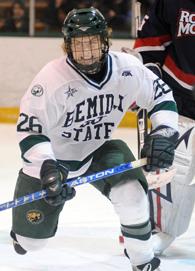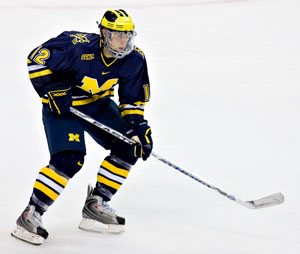Here’s an old tried-and-true column format: the hot-and-cold list. Join me as we narrow a big-picture view of ECAC Hockey down to a few noteworthy teams, units, and players.
Who’s Hot …
Colgate
Specifically, the offense and Charles Long. The Raiders have scored 16 goals in their last four games, and eight in each of the last two weekends. The ‘Gate hasn’t scored that many goals in a four-game stretch since late February 2008, and that was mostly thanks to an 8-0 win over Union to kick-start the run. Want to know the last time that Hamilton Hockey potted three goals in four consecutive outings? Try Jan. 13-21, 2006. Every team craves consistent productivity over unpredictable pyrotechnics, so take heart Raider fans; you just might have something to work with.
Sophomore Austin Smith has a half-dozen goals already, and Hobey candidate David McIntyre has nine assists and 11 points through nine games. This success on the scoreboard all comes in spite of a power play that ranks 53rd of 58 Division I teams, scoring only five goals in 51 advantages to date.
Long is making sure the offense’s efforts are worthwhile, holding a 1.70 goals-against average and .946 save rate in two league games, and has allowed five goals on 76 shots in his last three appearances.
Quinnipiac
The Bobcat offense is always fierce, and this year is no exception as the Q has 29 goals in seven games and hasn’t scored fewer than three in any one outing. But here’s a change of pace: the QU defense may finally be coming around.
After years of high-scoring, up-and-down, run-and-gun hockey, Rand Pecknold may have gotten his message through to what has long been a second-rate defense. If you can throw out Halloween’s 8-5 loss at Robert Morris, the ‘Cats have given up a measly nine goals in six games, and that eight-goal blemish marks the only contest in which the squad surrendered more than two.
“Absolutely, we’ve been very good defensively as a team for six of our seven games,” said Pecknold. “It’s definitely been a strong point on the team, it’s been something we’ve been focusing on, and fortunately we’re also finding a way to score goals.
“We’ve got a ton of freshmen D — we’ve got five on the roster — so we are young back there. We actually have 13 freshmen, so we’re a young team. There are some positives to that: they’ve certainly infused a lot of energy into our program; I think that’s been a positive. I think a huge positive, probably more than anything, has been my senior class. It’s really stepped up and responded from a leadership standpoint, and the chemistry in our locker room has been excellent so far. Overall, guys are just buying in.”
The goaltending triumvirate of freshmen Mathieu Cadieux and Eric Hartzell and sophomore Dan Clarke each post save percentages at .924 or better, and Clarke’s 2.6 goals-against average is the worst of the three by more than half a goal.
“The media keeps asking me about the goalie thing,” Pecknold said of his current three-way rotation, “and my answer across the board is textbook: It’s going to play itself out.”
Quinnipiac players are still spending a hefty amount of time in the box — see the 15 penalties, 41 minutes, and 13 shorthanded situations absorbed against the Saints on Saturday — but the penalty kill is holding so far at 88.4 percent overall, and the power play — when it gets its chance — has lit the lamp on one power play out of five.
“I thought we took some bad [penalties] on Saturday, a couple … I guess I would just call them stupid,” stated Pecknold, “and a couple were selfish. We need to clean that area up. I didn’t think it was a huge concern before Saturday — I certainly thought we could get better in that area, but Saturday was bad. We just took some really bad ones, and we need to clean that area up.
“I don’t think, by any means, that we’re as good as we can be,” reiterated the coach. “We need to get a lot better. But what’s happened is that in some of these games where we haven’t played our best, we’ve still found a way to win. I’m not sure if that’s because we’re a good team, or if it’s a little bit of luck. I guess once we get a bigger sample size on the season, we’ll have a better idea of that.”
Cornell
Has anyone noticed that the Big Red power play is scoring four times out of nine?
Seriously?
The PK unit has killed 16 of 18, the Red are blowing the opposition out 7-1 in the third period, and Ben Scrivens — remember him? — holds a .922 save percentage and a goals-against average under 2.0. More than a dozen skaters (13, to be precise) have been written into the scoring through three games.
Just another indomitable-looking team out of Ithaca, I suppose.
Broc Little
The Yale third-year has four goals in three games, including a game-winner, a power-play goal, and a shorthanded tally. He looks good to beat his freshman-year 11, and likely his sophomore-year 15. At this rate, he’ll beat them both combined.
Chase Polacek
RPI’s junior striker has six goals in his last six games, with six helpers to boot. He’s already matched his seven rookie-year goals, and doesn’t have far to go to meet last year’s 11-goal, 21-point total.
Rookies
Harvard phenom Louis Leblanc (2-3-5, three games), Yale’s Andrew Miller (1-3-4, three games) and St. Lawrence’s Kyle Flanagan (4-7-11, nine games) rank one-three-five on the national rookie scoring list, listed by points-per-game. Combined, this trio has 20 points in 15 games. Keep an eye on first-year Engineers Brandon Pirri (6-4-10) and Jerry D’Amigo (3-6-9) as well. That’s a lot of points in a significant number of games already (10).
… and Who’s Not
The rest of the Ivy League
First, one error to correct: In remarking on Yale’s five-goal outburst at Princeton last week, I mistakenly noted that Tigers goalie Zane Kalemba had allowed five goals in two of his last three games. This was erroneous, as the Bulldogs only scored four of their five goals against the Hobey Baker candidate — the fifth was planted in an empty net.
Besides that, though, five of the six Ivy programs have been perfectly capable of making their own mistakes thus far. Apart from 2-0-0 Cornell, the Ivy League is a combined 2-8-2, with last year’s overachieving sensation — Dartmouth — bringing up the rear at 0-3-0.
The Big Green have been outscored 13-6 in their three ECAC Hockey contests to date, and it’s no coincidence that the team’s penalty kill has been a positively abominable 10 for 17 — worst in the nation at 58.8 percent. The power play is a disaster as well with two goals in 18 opportunities, and the squad is already serving 23 minutes a game in the box. These issues have undeniably factored into sophomore Jody O’Neill’s .863 save rate, but he’ll have to step up as well if the Green are to secure another home playoff series.
Sure, Yale beat Princeton in the Garden State, but what have you done for me lately? That game was a non-conference contest, and in the Bulldogs’ league-opening weekend, the unanimous conference favorites slunk out of the Capital District with a single point to show for their mileage. RPI piled on the Blue & White with three unanswered goals in the last 37 minutes of Friday’s 5-2 decision, while the Elis required a Sean Backman extra-attacker goal with seven seconds left on Saturday to salvage a draw with Union. Yale was 1-of-10 on the power play on the weekend, and was beaten 7-3 in five-on-five play.
Yale’s travel partner Brown may not carry the same burden of external expectations that the other Ivies do this year, but under new head coach Brendan Whittet, the reinvented Bears can’t be happy with the way last weekend evolved. Friday’s 3-1 lead after 24 minutes at Union evaporated into a 3-3 tie thanks to two Mike Schreiber goals, and Bruno’s only offense on Saturday was found in a 5-on-3 power play in a 3-1 loss at Rensselaer. Goaltender Mike Clemente stopped 54 of 60 shots on the road trip, but his offense mustered a mere 38 — 19 each night. The special teams will need work, as the power play went 1-for-9 and the kill allowed three goals in 13 shorthanded situations.
Down in Jersey, Princeton has all the pieces to be an elite team in college hockey … but it’s still early, and the pieces don’t make a pretty picture just yet. The penalty-killing unit is gorgeous, a perfect 13-for-13, but that’s not an especially desirable number of unmatched penalties to be taking in a single weekend. Defending ECAC Hockey and Ivy League Player of the Year Zane Kalemba has had an uncharacteristically pedestrian start, posting a 2.7 goals-against average and .917 save percentage with a 1-2-0 record. The stalwart senior may feel a little heat from junior Alan Reynolds, who helped the Tigers rebound from Friday’s 5-2 loss to St. Lawrence with a one-goal, 31-save show in Saturday’s 4-1 victory over Clarkson.
Harvard may have beaten Dartmouth to open its season, but letting consecutive 3-1 second-period leads at Colgate and archrival Cornell end in losses is sure to drive coach Ted Donato to an unhealthy Pepto habit. On Friday, the Crimson led 3-0 after one and 4-1 after 40 minutes, but with under 10 minutes to play the Raiders scored three goals in 5:23 to steal two points. In Saturday’s tilt at Lynah Rink, Donato switched out Friday starter Kyle Richter in favor of junior Ryan Carroll. Once again, the Cantabs built a 3-1 lead — this one held through 37 minutes of play — before the Big Red erupted for five goals over the following 16 minutes of hockey. This sent the Crimson home with a solid cup-check of a loss, 6-3, and no protection in sight.
Readers’ Poll
Last week’s shootout poll received more posts and votes than any of the three previous surveys, apparently because people feel pretty strongly about their old-school hockey.
Despite forgetting an option regarding in-season tournament scenarios, a whopping — and yes, you can actually hear the majority “whop” on this one — 39 of 53 voters struck down shootouts as the most unholy of all Satan’s cruel designs. A small but significant five voters, on the other hand, can’t get enough of shootouts, voting in favor of the tiebreaker in all applicable situations. A few more individuals rallied for the format’s regular-season appearance, and one Brown fan declared himself a Communist.
Intrigued, I e-mailed ECAC Hockey’s head-coaching fraternity to ask its opinion. Six coaches got back to me (there are a few others who don’t even own computers, I’m beginning to suspect), with a few differing opinions.
Four coaches support the idea of regular-season shootouts to determine league standings, but not PairWise rank (those games would go down as ties, in the NCAA’s eyes). The remaining two coaches declared themselves totally opposed to the idea, with one elaborating that with so few league games compared to other conferences, such a format would have a correspondingly greater (and ergo less desirable) impact on the standings than it might in other leagues.
That will be a tough question to compete with, but let’s give it a shot: when, if ever, is it acceptable to boo a collegiate hockey player? This inquiry is sure to get a rise out of some of you, so by all means, make your voices heard. I look forward to the forthcoming carnage.


